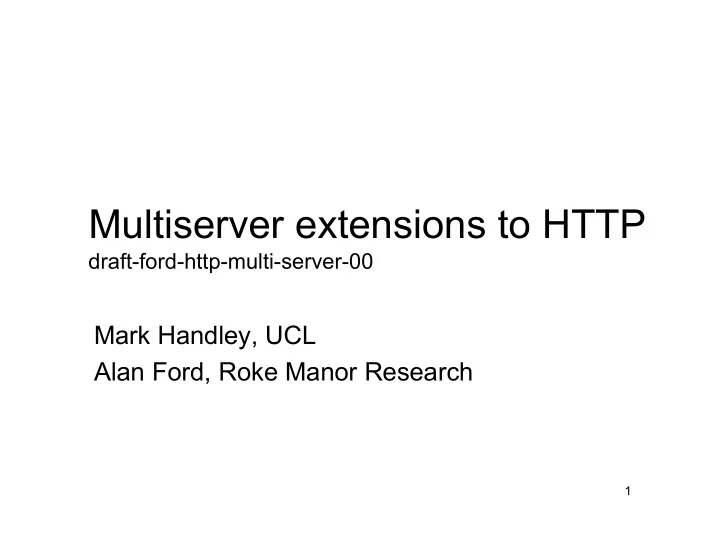

Multiserver extensions to HTTP draft-ford-http-multi-server-00 Mark Handley, UCL Alan Ford, Roke Manor Research 1
General Idea • Have one HTTP client pull different parts of the same document from multiple mirror servers simultaneously. 2
Mirroring • Common solution to spreading load across more than one server/site. – Manual choice of mirror doesn’t work well; primary site takes most of the load. – Auto mirroring works fairly well at balancing server load. • DNS load balancing (a bit of a hack). • Front-end load balancing (if all your servers are at one site). • No mirroring solution balances network traffic well. 3
BitTorrent • Very effective solution for serving content from many unreliable peers. – Divide content into blocks. – Peer with many peers. – Pull blocks from the fastest peers. • (also because it’s P2P, upload to peers) • Very robust to server overload or failure. • Makes extremely good use of spare network capacity and avoids using congested paths. 4
Multiserver HTTP • Robustness of BitTorrent for managed web servers. – Resilience to server or net outages. – Allows geographic distribution of servers. • Avoids congested paths, and automatically load balances the network. – Works for multihoming, as well as geographic distribution of mirrors. 5
Basic Idea • Client advertises multi-server capability in HTTP request. • Server advertises set of mirrors in response. – Uses chunked encoding. – Starts sending first chunk of requested data. • Client can request additional chunks from other mirrors in parallel. – Sends more requests to mirrors that respond fastest. • Result: most data from fastest mirrors. 6
Increased net performance • No need to pick a mirror and stick with it. – Try four in parallel. – Download from the fastest three. – Use the fourth TCP connection to experiment with new mirrors. • Very little data is sent along congested paths. 7
Increased server performance • Use one port for initial request, a second port for subsequent mirror requests. – Prioritise initial requests. • Failed initial requests are noticeable by user. – Serve mirror chunk requests as capacity allows. • Each chunk served eases work on some other mirror. • Result: a busy set of mirrors offload work to each other, to maximise overall performance. • Possible extension: the initial server could send no data, or very little data, when overloaded, and then move all load to mirrors. 8
HTTP Request Extensions X-Multiserver-Version: – in requests, declares capability and version X-If-Checksum-Match: – conditional on mirror chunk request. Only return the chunk if the checksum given matches that of the data. Range: – regular HTTP range request used to say which chunk is required. 9
HTTP Response Extensions X-Multiserver-Version: – Declares server’s multi-server HTTP version X-Checksum: – Used in response to initial request. – Data checksum, used to ensure all chunks are from the same version of the content X-Mirrors: – Used in response to initial request. – List of URLs that mirror the content. Content-Range: – regular HTTP content range used to indicate the chunk being sent. 10
Example: Initial Request GET /wibble/download.zip HTTP/1.1 Host: www.example.com X-Multiserver-Version: 0.1 11
Example: Initial Response HTTP/1.1 200 OK Accept-Ranges: bytes Content-Length: 10240 Content-Type: application/zip Content-Range: bytes 1-10240/2025121 X-Multiserver-Version: 0.1 X-Checksum: MD5 "d6862c992a3d6736ad678cc865dee67f" X-Mirrors: /wibble/download.zip 3600 \ http://www.example2.com/wibble/download.zip \ http://www.example3.com/wibble/download.zip First chunk of data…. 12
Subsequent chunk requests GET /wibble/download.zip HTTP/1.1 Host: www.example.com X-Multiserver-Version: 0.1 Range: 10241-20480 GET /wibble/download.zip HTTP/1.1 Host: www.example2.com X-Multiserver-Version: 0.1 X-If-Checksum-Match: MD5 "d6862c992a3d6736… Range: 20481-30720 13
A chunk response HTTP/1.1 200 OK Accept-Ranges: bytes Content-Length: 10240 Content-Type: application/zip Content-Range: bytes 10241-20480/2025121 X-Multiserver-Version: 0.1 …this chunk of data... 14
Details • How to handle checksum failure? • How to handle mirror failure during chunk download? • How best to manage connection pool with using too many parallel connections? • How to ensure a request pipeline from a client stays full to each active server? • How to allow overloaded servers to express policy and move load efficiently? • We have an implementation that works well – Credit: Javier Vela Diago – Lots of possibility here for good client heuristics. 15
Uses • Very good for very large file download. – Music or video download (eg. iTunes, BBC’s iPlayer) – Software download. – Streaming video over HTTP • May be good for many small images if wildcarding could be used appropriately. – Fetch most images from fastest mirror. 16
Uses • Mirror URLs can even be different interfaces on the same server. – More traffic transferred over the less congested link. – Dynamic load-balancing of a multi-homed site. 17
Summary • Very simple extension to HTTP – Could significantly improve net and server pool behavior. • Very few changes required on server. • Most work happens on client. – Even a fairly dumb implementation gets very good performance. 18
The Bigger Picture • This is part of a larger effort to improve the robustness of the Internet, improve its ability to self-balance traffic, and better match costs to revenues. • Other complentary work here: – Multi-path TCP – Re-ECN – LEDBAT congestion control for BitTorrent – Network Neutrality talks at Thurs Plenary. 19
Recommend
More recommend